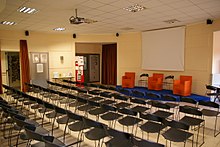Museo della Deportazione
The Museo della Deportazione e Resistenza ( Deportation and Resistance Museum ) with the attached Centro di Documentazione ( Documentation Center ) is a non-profit foundation in the north of the Italian city of Prato (Figline district) in Tuscany . The director of the facility is Camilla Brunelli .
history
On September 6, 1944 - the day the city of Prato was liberated from German occupation - there was a massacre of 29 young partisans in Figline , who were hanged by a German Wehrmacht unit in retreat. It was one of hundreds of mass murders committed by German troops in the Tuscany region.
Today's museum and documentation center are just a stone's throw from the site of the massacre at the time.
The content of the exhibition, however, is marked by another historical event: In March 1944, following a general strike hundreds Tuscans and over one hundred Prato in the in the occupied northern and central Italy Mauthausen concentration camp and the majority continue in the subcamp Ebensee deported .
When choosing the location of the museum, a factory hall in the center of the city was therefore also under discussion. In the end, however, it was decided in favor of Figline as an “authentic site of a Nazi massacre”.
The initiative to set up a museum to commemorate the events of that time came from a few Prates survivors - most of them Roberto Castellani . The financing was taken over by the municipality of Prato and the museum and the documentation center could be opened on April 10, 2002 in a solemn ceremony in the presence of the then Italian President Carlo Azeglio Ciampi .
The institution was initially under the administration of the municipality, but since February 2008 it has been a foundation established by the municipalities of the Prato Province , the ANED ( National Association of Former Political Deportees in Nazi Camps ), the Associazione Nazionale Partigiani d'Italia ( National Association of Partisans of Italy ) and the Jewish Community of Florence was founded.
Since 2008, the museum has also been an agency for the Austrian Foreign Service.
exhibition
After a thematic introduction to the Nazi camp system, the Mauthausen concentration camp with its subcamp Ebensee, and an overview of the deportation from the Tuscany region, the main part of the exhibition, which extends over around 70 square meters, consists of objects from the tunnels of the Ebensee concentration camp . These were collected in the 1970s by Prates survivors and fellow citizens and finally donated to the museum.
In addition, the former bell of the roll call area of the Ebensee camp can be found in the museum, which is a loan from the Ebensee community and an expression of the Prato-Ebensee town partnership , which was concluded in 1987.
The content of the museum is aimed particularly at pupils from the 8th grade, but also at interested citizens of the region and from abroad. Entry is free.
The documentation center
On the first floor of the building the documentation center is housed, which is a technically modern conference hall with 70 seats, an approximately 3,000 media comprehensive library features and three computer terminals. The research work is carried out not only in cooperation with local institutions and experts, but also in the context of international projects and in cooperation with the partner institution, the Contemporary History Museum Ebensee .
gallery
Web links
- Institution website (in Italian)
- Website of the contemporary history museum Ebensee
- City partnership Prato-Ebensee
- Austrian memorial service
Coordinates: 43 ° 55 '22.6 " N , 11 ° 5' 32.9" E





